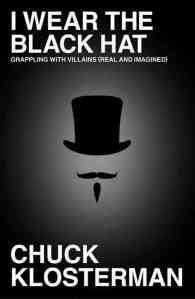By Brent Glass (@BrentAMG)
First and foremost, I must give credit to Blake Baxter for introducing me to Chuck Klosterman. A regular contributor to Esquire, ESPN.com, and the “Ethicist” columnist for The New York Times Magazine, Klosterman has also authored nine books. The first book I read was Baxter’s copy of Visible Man. After reading it, I was a believer. When perusing Amazon.com to find fresh books to read (and to make the most of my free month of Prime), I noticed Chuck’s latest book came out on July 9. I was all in.
A villain is “the one who knows the most but cares the least.” This is the sentiment Klosterman echoes throughout his latest work, I Wear the Black Hat: Grappling with Villains (Real and Imagined). A very simple, yet profound, statement by the man who has consistently given reason to things thought to be unreasonable. Throughout the book, Klosterman addresses different aspects of villainy. From what makes a villain villainous to how some figures such as Batman are heroes in the abstract but villains in actual life, Mr. Klosterman takes the reader on a fun ride.
Why is it that a boy generally likes Luke Skywalker but as he grows he leans toward Han Solo and, ultimately, Darth Vader? This is a question that caused Chuck to write this book. Klosterman discusses what the epitome of an evil act is: Tying a woman to train tracks. Why? Because this evil cliché embodies Klosterman’s definition of a villain. Think about it. In theory, the villain knows when the train will reach the victim, they realize that the innocent will wait in agony as the train steams forward, and they don’t give an eff. Actually, the villain gets his, or her (not sexist here), rocks off to how little they care. A villain is the one who knows the most but cares the least.
Klosterman also explores why Bernie Goetz became a villain the public’s eyes, why Andrew Dice Clay is only hated today, how the Oakland Raiders are intentionally villainous, how Bill Clinton avoided becoming condemned, and what Kareem Abdul-Jabbar and O.J. Simpson have in common.
I’m certain the author has been asked why he chose to write on villain. Does he have a dark obsession with villains? Is he a villain himself? Certainly not in the way an average person thinks of a villain. However, after reading this book one gets the impression that Chuck is a villain in his own way. And if Chuck is a villain, are we? I wear the black hat.
Overall, I thought Chuck Klosterman delivered. He took a subject that has become a fixture of American popular culture today. The great television shows of the past decade – The Sopranos, The Wire, Breaking Bad, and Mad Men – all featured anti-heroes. It is clear that Americans are intrigued by complex characters who have a dark side. Probably because Americans are cognizant of their dark side and identify with these characters. I Wear the Black Hat helped me understand why Americans think this way. We all wear a hat. What color is yours? 4.25/5
Brent Glass is a Michigander who graduated from Eureka College in May of 2013. He spent time at the Sagamore Institute in Indianapolis, IN (a non-partisan think tank) where he worked on political economy pieces for Detroit, MI and Elkhart, IN. Additionally, he spent the summer of 2012 at the Ronald Reagan Presidential Library in Simi Valley, CA, working on social media management. Currently he is beginning a marketing project designed to expand the reach of Sagamore Institute and Eureka College, creating a social media management business, Connect You Consulting, and working full-time as a Management Assistant to the owner of a car dealership. He plans to further his education in the fall of 2014 in either public policy, political science or business.
Categories: Books

Leave a comment